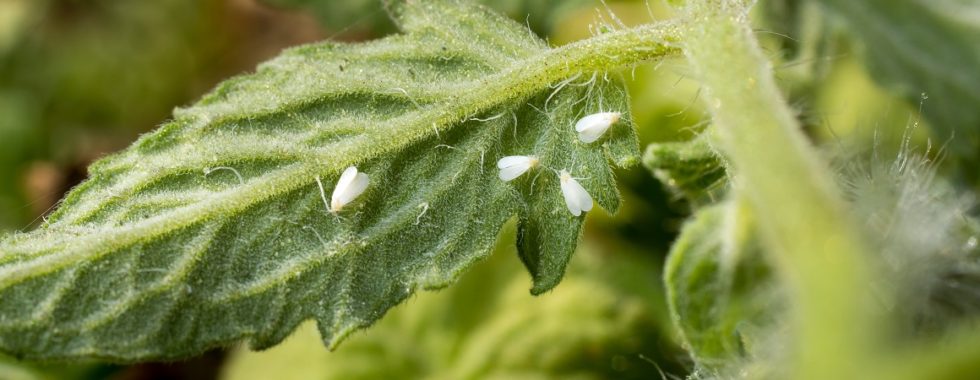Whitefly – a tiny, devastating pest
Whiteflies belong to the order Hemiptera. They are related to aphids, scales and mealybugs.
Whiteflies are tiny (0.8-1.5mm long), yellowish insects, with white wings. The origin of their name comes from the white wax that covers their wings.
They feed on plant sap and are a pest of many field and greenhouse crops, such as tomato, potato, cucumber, eggplant pepper, squash, cotton, citrus and a variety of flowers and bedding plants. have mouthparts of piercing and sucking. This type of mouthparts allow the whitefly to pierce the plant tissue, insert a tube and suck the liquids.
DAMAGES CAUSED BY WHITEFLY
Whiteflies can cause both direct and indirect damages.
Direct damages and symptoms include weak plants and yellow mottled leaves, which are a direct result of their feeding.
Whiteflies also secrete a sticky thick liquid, which is composed mainly of carbohydrates, called honeydew. The honeydew favors the development of black sooty mold fungus. As a result, at high whitefly infestation you may notice leaves covered with black mold. This is an indirect damage caused by whiteflies.
Other pests from the Hemiptera order also secret honeydew and therefore, black sooty mold is not a unique symptom of whitefly presence.
In many countries, finding whiteflies in an agricultural shipment imported to the country, is enough to reject the import, even if there are no damage symptoms.
However, the indirect damage caused by whitefly – transmission of plant viruses – can result in significant economic losses and is considered to be the most significant damage caused by whitefly.
LIFE CYCLE OF WHITEFLY
Development stages of whitefly include eggs, various stages of nymphs and adults.
The duration of whitefly’s life cycle depends on the temperature. Development and growth are much quicker in warm temperatures. Mild moist conditions with temperature of 30°C favor whitefly development.
Averages of the duration of the different life stages are presented in the following table.
| Temperature | Egg hatch (days) | Nymphs I-II-III (days) | “Pupa” (nymph IV, days) |
| 15°C | 18 | 25 | 24 |
| 18°C | 11 | 17 | 12 |
| 21°C | 8 | 11 | 8 |
| 24°C | 6 | 8 | 7 |
| 30°C | 3 | 7 | 7 |
HOW TO DETECT AND IDENTIFY WHITEFLIES?
Adult stages are small, white and can fly. They live as long as 2 moths. Females lay up to 400 eggs during their life.
Nymphs are flattened, oval and do not crawl (except of in the 1-2 days after hatching)
Adults can be found on both sides of leaves, although they prefer the underside of the leaves.
Adults are usually gather at the top of the plants, while eggs and nymphs are found on the underside of lower leaves.
While scouting, disturb the foliage slightly. This will make detection easier, as whiteflies will rise and quickly sit back on the leaves. In heavy infestation, a “cloud” of whiteflies will rise to the air.
If adult whiteflies are detected, monitor the underside o the lower leaves for eggs and nymphs, using a hand lens.
In greenhouses, you can use yellow sticky traps to trap whitefly adults. Use 1 trap per 100m2.
WHITEFLY SPECIES
There are many species of whiteflies (over 1500). However, the two dominant as species are Silverleaf whitefly (Bemisia tabaci strain B) and Greenhouse whitefly (Trialeurodes vaporariorum). These are also the only species that can transmit viruses.
By naked eye, it is difficult to tell the difference between the adults of those two species.
The wings of the greenhouse whitefly have a shape of a a triangle, while the wings of Silverleaf whitefly are straight.
It is easier to distinguish between the pupae: pupae of greenhouse whitefly are white and almost straight, while pupae of Silverleaf whitefly are yellowish and have a more rounded shape.
WHITEFLY AS A VECTOR OF PLANT VIRUSES
Whiteflies are a vector of many viruses. They acquire the virus while they feed on plant sap. It takes around 15 minutes of feeding until the whitefly acquires the virus and another 15-30 minutes to transmit the virus to other plants.
It is important to remember that a pest can be a vector of many viruses, while, a specific virus usually has only one host.
Most of the viruses transmitted by whiteflies, are transmitted by Bemisia tabaci biotype B (silverleaf whitefly). Trialeurodes vaporariorum (greenhouse whitefly) is a vector of a few viruses.
114 known viruses are transmitted by Bemisia tabaci . Some examples include:
Tomato yellow leaf curl virus (TYLCV), from the Begomovirus genus.
Cucurbit yellow stunning disorder virus (CYSDV), from the Crinivirus genus.
Sweet potato chlorotic stunt virus (SPCSV), from the Crinivirus genus.
Cucumber vein yellowing virus (CVYV), from the Ipomovirus genus.
Greenhouse whitefly, Trialeurodes vaporariorum transmits 3 virus species:
Beet pseudo-yellows virus, which is a virus of cucumber, melon lettuce and sugarbeet.
Tomato infectious chlorosis virus (TICV)
Lettuce infectious chlorosis virus (LICV)
Identifying the whitefly specie is important in order to evaluate the potential of virus transmission and also in order to apply an adequate treatment.






